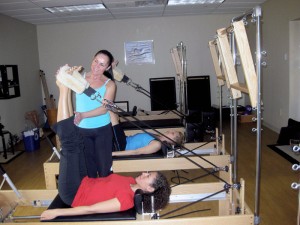by Michelle Sutton-Kerchner
It may be a stiff back from that last snow-shoveling frenzy, or a long-term kink in your neck. Whatever the cause, there is a workout to help …
 When suffering from achy joints and sore muscles, simple movement may cause discomfort or even pain. Exercise may seem counterproductive, especially when you are reluctant to lift a laundry basket for fear of further injury. The idea of pumping iron or grooving in a fitness class may seem ludicrous. Research proves otherwise.
When suffering from achy joints and sore muscles, simple movement may cause discomfort or even pain. Exercise may seem counterproductive, especially when you are reluctant to lift a laundry basket for fear of further injury. The idea of pumping iron or grooving in a fitness class may seem ludicrous. Research proves otherwise.
An appropriate fitness regimen can help accelerate efforts to overcome injury or chronic pain. Exercise helps avoid further setbacks by increasing muscle and tendon strength and flexibility. It also improves the body’s pain threshold by increasing your tolerance to pain.
Give the heating pad and ibuprofen a rest while you take action!
Get Specific

A proper fitness program may help the body repair from an injury or chronic aches. However, most of us need help determining the specifics: which exercises, how many, how often, and (for motivation) the details on what they are accomplishing.
Always consult with your physician first. Learn about the origin of your pain and how best to proceed. Perhaps physical therapy would be helpful before you segue into official workouts. Both are available at the Center, with therapists and trainers working together to evolve your program.
Soothe
Surround yourself in the warm water of the Center’s pool. Enjoy the fluid movements of your weightless body. Often, the pool is the best introduction to exercise for a sore body. Joints and muscles are cradled by the water’s support while simultaneously challenged with its gentle resistance.
Use the spa pool to loosen muscles before working out or prior to any prescribed physical therapy. The sauna is another way to warm muscles and aid flexibility.
When finished exercising, apply ice to painful areas. Inflammation can be exacerbated by use. With exercise, you are definitely putting the body to use! Ice applications will help reduce inflammation.
Focus on the Core

Considered the body’s movement headquarters, the core includes the stabilizing muscles around the abdomen, pelvis, and back. Almost all physical activity involves the core. Keep it strong and happy to avoid injury and improve every day movement.
When dealing with pain related to the spine, training the core can be tricky. Traditional methods like crunches can increase back and neck pain, even when done correctly. Find therapeutic ways to strengthen your core.
Ask a physical therapist, Pilates instructor, or personal trainer for exercises that build a better core while respecting your sensitivities. Suggestions might include: wall push-ups, lateral band walks, and variations of the plank. Pilates often is helpful for those dealing with chronic pain. After all, it was created to help soldiers rehabilitate. A professional can help modify specific exercises even further to fit your needs and accommodate any limitations.
Monitor Your Pace
Despite your fitness level before you started experiencing pain, you still need to start or return to exercise slowly. Exercising with a goal of eliminating your nightly ibuprofen is different than working out to run a marathon. Fitness to improve functionality and reduce physical limitations requires patience, mindfulness, and plenty of time.
To overcome an injury or ease aches, increasing circulation and range-of-motion is priority. Improve blood flow throughout the body to accelerate your natural ability to repair. Pain causes us to be fatigued more easily. Consider breaking your workout into 20-minute increments as you rebuild stamina. Take breaks in between to hydrate, go for a walk, or float in the pool. Even avid athletes need to pace themselves when exercising to overcome an injury.
Do It Right

A personal trainer can perform a postural assessment (at the Center, done through FMS screening) to study your body mechanics. With that knowledge, a customized series of stretches and exercises can be created to maximize benefits and minimize injury. Also, a trainer can assure movements are properly executed so poor form does not cause additional issues.
Through corrective exercises, s/he can help prevent your body’s natural tendency to overcompensate in other areas to protect the painful one. If possible, consider signing up for several sessions beyond your complimentary quarterly assessment. Some extra professional guidance can leave that heating pad collecting dust.
A balanced, appropriate workout provides peace-of-mind. Your mental energy can focus on feeling better—not whether one more squat will land you on your back.
Sources
“Exercise and Pain Relief,” by Gina Shaw at webmd.com.
“Exercise for Pain Relief: How to Establish a Habit That Really Helps,” by Peter Abaci at webmd.com.
 Fitness & Wellness News Your Source for Fitness News, Wellness News, Health News, and Nutrition News!
Fitness & Wellness News Your Source for Fitness News, Wellness News, Health News, and Nutrition News!




